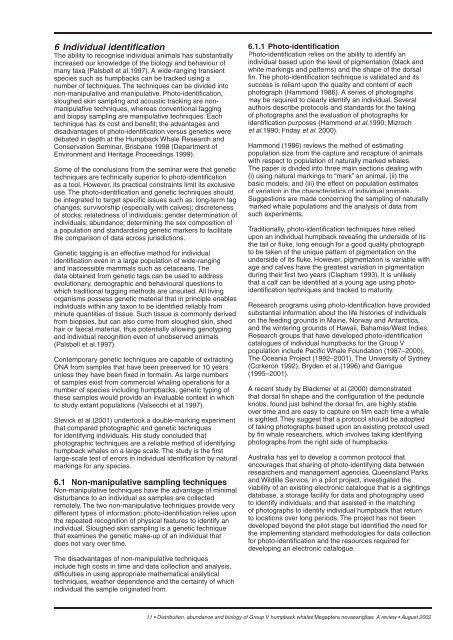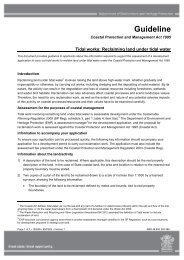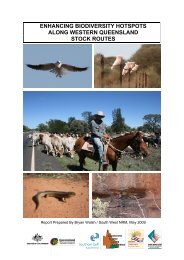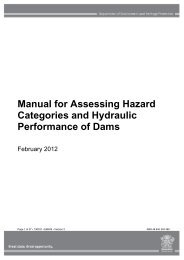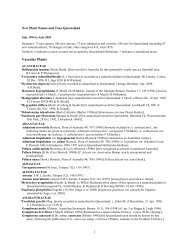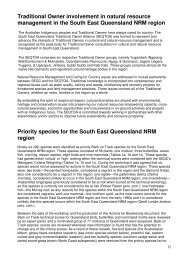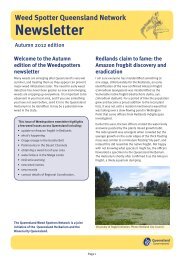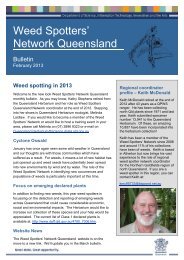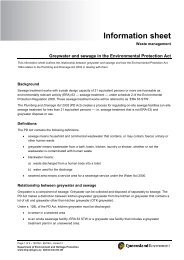Distribution, abundance and biology of Group V humpback whales ...
Distribution, abundance and biology of Group V humpback whales ...
Distribution, abundance and biology of Group V humpback whales ...
You also want an ePaper? Increase the reach of your titles
YUMPU automatically turns print PDFs into web optimized ePapers that Google loves.
6 Individual identifi cation<br />
The ability to recognise individual animals has substantially<br />
increased our knowledge <strong>of</strong> the <strong>biology</strong> <strong>and</strong> behaviour <strong>of</strong><br />
many taxa (Palsbøll et al.1997). A wide-ranging transient<br />
species such as <strong>humpback</strong>s can be tracked using a<br />
number <strong>of</strong> techniques. The techniques can be divided into<br />
non-manipulative <strong>and</strong> manipulative. Photo-identifi cation,<br />
sloughed skin sampling <strong>and</strong> acoustic tracking are nonmanipulative<br />
techniques, whereas conventional tagging<br />
<strong>and</strong> biopsy sampling are manipulative techniques. Each<br />
technique has its cost <strong>and</strong> benefi t; the advantages <strong>and</strong><br />
disadvantages <strong>of</strong> photo-identifi cation versus genetics were<br />
debated in depth at the Humpback Whale Research <strong>and</strong><br />
Conservation Seminar, Brisbane 1998 (Department <strong>of</strong><br />
Environment <strong>and</strong> Heritage Proceedings 1999).<br />
Some <strong>of</strong> the conclusions from the seminar were that genetic<br />
techniques are technically superior to photo-identifi cation<br />
as a tool. However, its practical constraints limit its exclusive<br />
use. The photo-identifi cation <strong>and</strong> genetic techniques should<br />
be integrated to target specifi c issues such as: long-term tag<br />
changes; survivorship (especially with calves); discreteness<br />
<strong>of</strong> stocks; relatedness <strong>of</strong> individuals; gender determination <strong>of</strong><br />
individuals; <strong>abundance</strong>; determining the sex composition <strong>of</strong><br />
a population <strong>and</strong> st<strong>and</strong>ardising genetic markers to facilitate<br />
the comparison <strong>of</strong> data across jurisdictions.<br />
Genetic tagging is an effective method for individual<br />
identifi cation even in a large population <strong>of</strong> wide-ranging<br />
<strong>and</strong> inaccessible mammals such as cetaceans. The<br />
data obtained from genetic tags can be used to address<br />
evolutionary, demographic <strong>and</strong> behavioural questions to<br />
which traditional tagging methods are unsuited. All living<br />
organisms possess genetic material that in principle enables<br />
individuals within any taxon to be identifi ed reliably from<br />
minute quantities <strong>of</strong> tissue. Such tissue is commonly derived<br />
from biopsies, but can also come from sloughed skin, shed<br />
hair or faecal material, thus potentially allowing genotyping<br />
<strong>and</strong> individual recognition even <strong>of</strong> unobserved animals<br />
(Palsbøll et al.1997).<br />
Contemporary genetic techniques are capable <strong>of</strong> extracting<br />
DNA from samples that have been preserved for 10 years<br />
unless they have been fi xed in formalin. As large numbers<br />
<strong>of</strong> samples exist from commercial whaling operations for a<br />
number <strong>of</strong> species including <strong>humpback</strong>s, genetic typing <strong>of</strong><br />
these samples would provide an invaluable context in which<br />
to study extant populations (Valsecchi et al.1997).<br />
Stevick et al.(2001) undertook a double-marking experiment<br />
that compared photographic <strong>and</strong> genetic techniques<br />
for identifying individuals. His study concluded that<br />
photographic techniques are a reliable method <strong>of</strong> identifying<br />
<strong>humpback</strong> <strong>whales</strong> on a large scale. The study is the fi rst<br />
large-scale test <strong>of</strong> errors in individual identifi cation by natural<br />
markings for any species.<br />
6.1 Non-manipulative sampling techniques<br />
Non-manipulative techniques have the advantage <strong>of</strong> minimal<br />
disturbance to an individual as samples are collected<br />
remotely. The two non-manipulative techniques provide very<br />
different types <strong>of</strong> information; photo-identifi cation relies upon<br />
the repeated recognition <strong>of</strong> physical features to identify an<br />
individual. Sloughed skin sampling is a genetic technique<br />
that examines the genetic make-up <strong>of</strong> an individual that<br />
does not vary over time.<br />
The disadvantages <strong>of</strong> non-manipulative techniques<br />
include high costs in time <strong>and</strong> data collection <strong>and</strong> analysis,<br />
diffi culties in using appropriate mathematical analytical<br />
techniques, weather dependence <strong>and</strong> the certainty <strong>of</strong> which<br />
individual the sample originated from.<br />
6.1.1 Photo-identifi cation<br />
Photo-identifi cation relies on the ability to identify an<br />
individual based upon the level <strong>of</strong> pigmentation (black <strong>and</strong><br />
white markings <strong>and</strong> patterns) <strong>and</strong> the shape <strong>of</strong> the dorsal<br />
fi n. The photo-identifi cation technique is validated <strong>and</strong> its<br />
success is reliant upon the quality <strong>and</strong> content <strong>of</strong> each<br />
photograph (Hammond 1986). A series <strong>of</strong> photographs<br />
may be required to clearly identify an individual. Several<br />
authors describe protocols <strong>and</strong> st<strong>and</strong>ards for the taking<br />
<strong>of</strong> photographs <strong>and</strong> the evaluation <strong>of</strong> photographs for<br />
identifi cation purposes (Hammond et al.1990; Mizroch<br />
et al.1990; Friday et al. 2000).<br />
Hammond (1986) reviews the method <strong>of</strong> estimating<br />
population size from the capture <strong>and</strong> recapture <strong>of</strong> animals<br />
with respect to population <strong>of</strong> naturally marked <strong>whales</strong>.<br />
The paper is divided into three main sections dealing with<br />
(i) using natural markings to “mark” an animal, (ii) the<br />
basic models, <strong>and</strong> (iii) the effect on population estimates<br />
<strong>of</strong> variation in the characteristics <strong>of</strong> individual animals.<br />
Suggestions are made concerning the sampling <strong>of</strong> naturally<br />
marked whale populations <strong>and</strong> the analysis <strong>of</strong> data from<br />
such experiments.<br />
Traditionally, photo-identifi cation techniques have relied<br />
upon an individual <strong>humpback</strong> revealing the underside <strong>of</strong> its<br />
the tail or fl uke, long enough for a good quality photograph<br />
to be taken <strong>of</strong> the unique pattern <strong>of</strong> pigmentation on the<br />
underside <strong>of</strong> its fl uke. However, pigmentation is variable with<br />
age <strong>and</strong> calves have the greatest variation in pigmentation<br />
during their fi rst two years (Clapham 1993). It is unlikely<br />
that a calf can be identifi ed at a young age using photoidentifi<br />
cation techniques <strong>and</strong> tracked to maturity.<br />
Research programs using photo-identifi cation have provided<br />
substantial information about the life histories <strong>of</strong> individuals<br />
on the feeding grounds in Maine, Norway <strong>and</strong> Antarctica,<br />
<strong>and</strong> the wintering grounds <strong>of</strong> Hawaii, Bahamas/West Indies.<br />
Research groups that have developed photo-identifi cation<br />
catalogues <strong>of</strong> individual <strong>humpback</strong>s for the <strong>Group</strong> V<br />
population include Pacifi c Whale Foundation (1987–2000),<br />
The Oceania Project (1992–2001), The University <strong>of</strong> Sydney<br />
(Corkeron 1992), Bryden et al.(1996) <strong>and</strong> Garrigue<br />
(1995–2001).<br />
A recent study by Blackmer et al.(2000) demonstrated<br />
that dorsal fi n shape <strong>and</strong> the confi guration <strong>of</strong> the peduncle<br />
knobs, found just behind the dorsal fi n, are highly stable<br />
over time <strong>and</strong> are easy to capture on fi lm each time a whale<br />
is sighted. They suggest that a protocol should be adopted<br />
<strong>of</strong> taking photographs based upon an existing protocol used<br />
by fi n whale researchers, which involves taking identifying<br />
photographs from the right side <strong>of</strong> <strong>humpback</strong>s.<br />
Australia has yet to develop a common protocol that<br />
encourages that sharing <strong>of</strong> photo-identifying data between<br />
researchers <strong>and</strong> management agencies. Queensl<strong>and</strong> Parks<br />
<strong>and</strong> Wildlife Service, in a pilot project, investigated the<br />
viability <strong>of</strong> an existing electronic catalogue that is a sightings<br />
database, a storage facility for data <strong>and</strong> photography used<br />
to identify individuals; <strong>and</strong> that assisted in the matching<br />
<strong>of</strong> photographs to identify individual <strong>humpback</strong> that return<br />
to locations over long periods. The project has not been<br />
developed beyond the pilot stage but identifi ed the need for<br />
the implementing st<strong>and</strong>ard methodologies for data collection<br />
for photo-identifi cation <strong>and</strong> the resources required for<br />
developing an electronic catalogue.<br />
11 • <strong>Distribution</strong>, <strong>abundance</strong> <strong>and</strong> <strong>biology</strong> <strong>of</strong> <strong>Group</strong> V <strong>humpback</strong> <strong>whales</strong> Megaptera novaeangliae: A review • August 2002


